Trending
Opinion: How will Project 2025 impact game developers?
The Heritage Foundation's manifesto for the possible next administration could do great harm to many, including large portions of the game development community.
The third and last part of "Don't show, involve" is about plotting and how the narrative can assist the stylish elements in the creation of a form that involves and evokes emotions.
#narrative #cognition #emotions #meaning #mechanics #plotting

The series "Don´t show, involve" builds upon the narrative as a cognitive process and how to go from a thought to the plotting of an involving experience. As to get the most out of the third and last part of the series”, which is about plotting and how the narrative can assist the stylish elements in the creation of a form that involves and evokes emotions, I would like to recommend reading the previous parts before continuing. They can either be found at Gamasutra or Narrative Construction (NC).
Part 1 Don´t show, involve – how to propel a thought towards a goal. (Gamasutra) (NC)
Part 2 Don´t show, involve – hands-on plotting towards a goal.(Gamasutra) (NC)
After following through the series the constructor´s cognitive process towards a goal/premise we will now look at the conversed propelling of thoughts by the means of the player´s learning of the plotting in relation to the constructor´s plotting of a gameplay and how a shared goal matters to the creation of an involving experience.
Illustration by Linnea Österberg
Since there is always a risk when diving into our heads and thoughts to end up in some kind of Vulcanic mind melding session of: “your mind to my mind, your thoughts to my thoughts”, we will revisit the thought based method Narrative bridging and the plotting of the online game “Journey” from the previous part to look at how the two cognitive activities of the constructor and the player can reach a goal of a feeling/meaning of an emotion.
Someone´s completion someone else’s beginning
When leaving the plotting of “Journey” in the previous part of “Don´t show, involve”, that had reached the goal/vision by making the form and style merge into a gameplay, the completion of the game looked like following in Narrative bridging (NB):
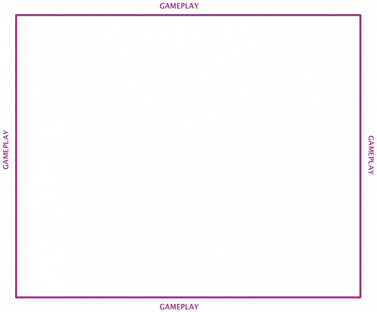
If we take the perspective of a constructor and position ourselves in the player´s position, the difference between the constructor and the player is that the constructor´s cognitive process is completed, but for the players, the process is just about to begin.
As the separation between the constructor and the perceiver of the construction plays a significant role in understanding in which order to follow the exchange of inputs and outputs between the player and the constructor (the system), the separation is also one of the fundamental principles behind the narrative as a cognitive process to reach a goal. By understanding the difference between the constructor´s plotting of gameplay and the player´s learning about the plotting (within narrative theory called the syuzhet and fabula) it gets a lot easier to understand how the narrative can assist the stylish elements in the creation of a form that involves and evokes emotions.
What the player knows
Let's say this is the first time a player will play “Journey” before any rumours or reviews have reached the player. What the player knows before playing the game depends on the information that has been filtered through the marketing of the game. Through the information that reaches the player, expectations will be built. Depending on prior experiences and knowledge the information will be evaluated by the player. If the information is “well balanced” the player may feel a curiosity. But as people like to stay with the familiar in order to explore the unfamiliar, if things are getting too unfamiliar, and as our emotions are always involved when we make a decision based on prior experiences and knowledge, depending on the level of “insecurity” to the new, the least we can do to propel the engagement towards an exploration of the game is to “speak” in a way so that the perceiver will “feel safe” in order to willingly explore the unfamiliar and become a player. What it means to speak in a “well-balanced way” is to let the expectations that are built corresponding to the goal that indicates what the player will experience, which is in the case with “Journey” expressed by Jenova Chen as “a feeling of awe, of catharsis, in an online world”.
What the constructor knows
If we return to the position of the constructor when the player is about to begin playing the game, from the constructor´s perspective the game is completed. This means that the constructor knows more about the game than the player does. So if we open Narrative bridging again from the previous part of the series as to look at what Jenova Chen and his team know about the game, it´s a lot.
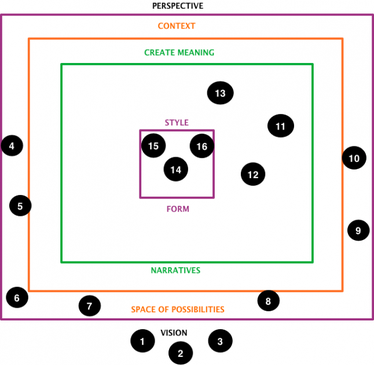
1. Not like World of Warcraft where people compete and feel lonely.
2. A feeling of accomplishment and empowerment that will make players care about each other.
3. A feeling of awe, of catharsis, in an online world.
4. Get rid of the power
5. Get rid of noisy stuff that distracts player's from each other.
6. Remove HUD so players get closer to each other
7. No ID (no nameplate)
8. No lobby
9. No guns
10. Get rid of players and make them two so they can focus on each other
11. Life cycle journey through; graveyard, waterfall, desert, canyon, cave, ruin, mountain, the summit
12. Resources are re-usable and dropped after being used by another player.
13. By being close players get extra power to complete a task together
14. Collaboration
15. Resources/power
16. Movements
When looking at all the parts a constructor knows, in relation to the player, it might seem a bit overwhelming, but what I´m trying to do is just to depict the difference between the constructor´s plotting of a gameplay and the player´s learning about the plotting as I´m about to move further and show the narrative as a cognitive process and how the separation between the constructors knowing in relation to the player´s learning aids the process to understand how the narrative can assist the stylish elements in creation of a form that involves and evokes emotions.
How to establish involvement and emotions
The reason why the feeling of an experience matters to the goal, which is something game developers are well aware of and where engagement-arcs use to be aligned to the plotting of sequences, it´s because through the goal the ends of thoughts will meet – the constructors and the players.
If we would like to involve the minimum amount of information needed, according to the narrative as a cognitive process to make the form and style propel a player’s core cognitive activities towards a goal, is to present something familiar and put it in relation to something unfamiliar (which I mentioned earlier). If the stylish elements of a game allow the player to move, the narrative will assist the player´s core cognitive activities as well as the stylish elements to enable a movement towards an object that the perceiver has identified and liked to explore. A curiosity is born. If the player starts to act towards an object, the first step of involvement is established. If allowing the player to repeat the cognitive activity through the plotting and the player moves further one can be sure that there are emotions involved.
As we followed the testing of “Journey” in the previous part of “Don´t show, involve” (based on an article at Gamasutra about the creation of Journey) where the players expressed negative emotions when testing the game that the game “sucked”, the question is how we can understand what the emotions mean from a narrative perspective as it is through the assisting of the stylish elements, to create a form, the goal can be reached?
Let's say that we are testing a game. As an involvement means that our emotions are switched on, if the emotions are expressed it can sound like the following: ”aww”, “oh”, “ah”, “eek”, “ops”, etc. If we ask, “what happened?” as to understand the expressive interjections of emotions, the response might be: it was good, it sucked, nice, interesting, terrible, exciting, etc. If we would like the player to elaborate the answer, we will be asking for someone´s creation of meaning (or basically a construction of narrative). As it´s rather important to know when testing a game what it means to ask for someone´s opinion compared to an emotion, I´d like to expand what meaning as a goal means from a narrative perspective on construction.
Meaning as a goal
The creation of meaning is very important. And for a constructor, the creation of a meaningful experience is a very desirable goal. As we all need meaning to understand and feel motivated the goal/premise for Chen and his team when creating “Journey” to create a feeling of “awe, of catharsis, in an online world” was how the team gave their work meaning in the construction of a form. But even if the team would have pointed a 500 watts lamp at a test-player as to see if the goal had been achieved by hearing the player say the sentence: “I feel awe, of catharsis”, it will not happen.
If we would ask people what they thought about the film “Forrest Gump” we can be prepared to hear a lot of meanings. Some meanings can be referential like; the film was about the American history. Another meaning can be explicit by pointing out a quote like: “life is like a box of chocolate, you never know what you´re going to get”, to be the overall function of the film. A meaning could also be more implicit where someone interprets the film from their own experience of a mother´s concern of her child´s low IQ and how the child will manage through life (which Forrest Gump manages very well by telling people that “stupid is as stupid does”). So if people start to create meanings about a game, it is great, as then we know that we have engaged people. But if we like to know more exact, the expression of an emotion can be more helpful - if we know what we are doing.
Let´s say we are magicians and that we are performing a magic number, which is very similar to the constructor´s position in the creation of an experience, the only way to know more exactly what needs to be adjusted in order to improve the experience is from the response of the audience. If we don´t hear applauds or “ooh!” from the audience, the only one that could tell what needs to be adjusted is the magician as the audience can´t know what the magician´s goal (meaning) is. And if working with entertainment where the whole point is to add something new and unfamiliar in order to surprise, what is the point of doing the trick if you have to ask the audience how to do it? Therefore the responsibility to meet the expectations is on the constructor to know the meaning of the goal that will create the form that will add to the experience, i.e. the learning.
The meaning of a shared goal
As a lot of practice in the creation of an involving experience is based on intuition and feelings when things are getting stressful the initial meaning of a goal/premise plays a crucial role to the creation of an overall form of gameplay.
Even if it´s not explicitly mentioned in the article about the creation of “Journey” the eventual stress and uncertainty Jenova Chen and his team experienced when testing the game and where the players expressed how the game sucked, from what Chen describes from the testing it seems to have been a moment when not everything was given on how to interpret the results from the tests in order to make adjustments. Among the negative responses from the tests there was one (1) player that expressed to have enjoyed himself more than the others as his game crashed at the end of the game, which Chen describes as having an impact on the team:
”But a revelation came when a player whose game crashed right at the end enjoyed himself more.”
Thus Chen´s description is too vague to make any conclusions from how much one (1) player´s experience had on the final adjustments and where the other players were expressing negative feelings of lack of control and going on a “rail” at the end of the game. But let´s say that Chen and his team worked on intuition and based their judgments on one (1) player´s experience, what would happen if the player´s game wouldn´t crash?
What easily happens in a situation when people work on intuition and if not knowing what a meaning from a narrative perspective means to the goal in the creation of a form, is that people are likely in a stressful situation in order to get in control seek the familiar if the unfamiliar is too unfamiliar. Let´s say that Chen and his team is withdrawing to go through the results of the tests and a boss comes in, who hasn’t worked directly with the construction, and says that he has identified market needs that players do not like to look like girls dressed in a skirt as that is not what players are used to in online games (and you feel that the underlying meaning is that the boss would rather like to see “Journey” turned into “World of Warcraft” as the unfamiliar feels too risky to explore). What would you say? It´s not a skirt, it´s a dress? One player liked it?
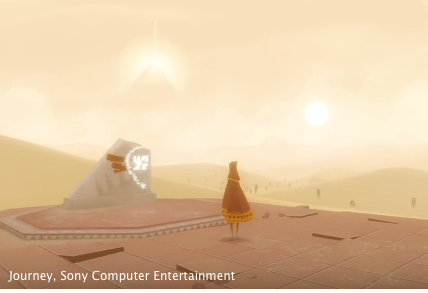
Journey, Thatgamecompany, Sony Computer Entertainment
When eventual stress, insecurity or boredom occurs during the different phases of a process the reason why everyone should cleave to the initial meaning of a goal, as Chen and his team did (as well as Fumito Ueda did, see Part 2 "Don´t show, involve") when making decisions, analysis, improvements, etc., is due to that the feeling of one (1) meaning, as in the case with “Journey”, of “awe, of catharsis” has embodied all the parts that have created the overall form of the gameplay. It means that a response from the players is from learning from one (1) form that the reactions are based on. But if giving new meanings to the initial meaning from the constructor´s side that can be referential, implicit or explicit it can become rather cumbersome. If we go back to the magician and had him changing meaning as to make the audience go "ooh" and applaud, he would never be able to find out the cause to the first reactions as a new meaning requires a "new test" as to know if it works. This, in turn, means that the magician will never learn from the initial responses in order to improve the initial meaning of a goal.
But even if everyone knows the importance of sharing the meaning of a goal/premise, a re-interpretation of the initial meaning of the goal is very likely to occur as the line is very fine between evaluate and having doubts. But how to detect when doubts are in play is when suggestions about the appearances, enlargements of muscles, chests, more blood on corpses, etc. occur. It´s then that you shall show the picture below and ask since when did the appearance matter on the engagement?

But jokes aside, knowing the basic principles behind an involvement (the familiar in relation to the unfamiliar) by letting the narrative assist the stylish elements to create a meaning to the overall form, what matters is how a feeling of an emotion, even if negative, can be more valuable than hundred meanings. And with the help from Narrative bridging, I will return to the plotting of “Journey” as to show how the players learning in relation to the constructor´s plotting can tell why a shared meaning is essential to the construction but how a feeling of an emotion can tell even more.
The player´s learning
If we take a closer look at the player´s learning of the plotting in relation to the constructor´s plotting of a gameplay, as to see how it plays along towards the goal, we will let the player press the start button:
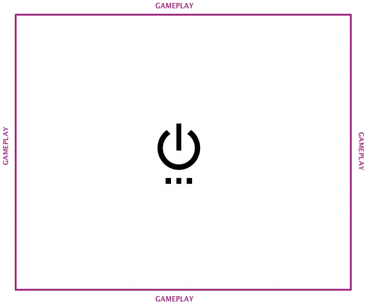
When starting the game the player activates the stylish elements of the form:
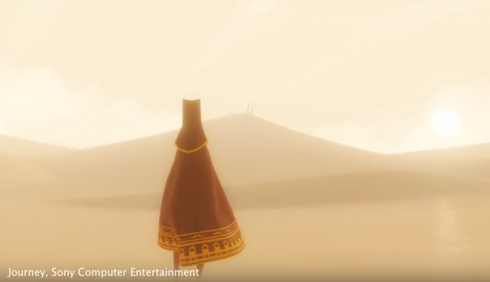
Journey, Thatgamecompany, Sony Computer Entertainment
In the same way as the artist´s painting, which I mentioned in the previous part, will lose the sense of materiality and smell of paint if moving its form to Instagram, the stylish elements of a game completely lose its power in this form. But as the picture above of the first sequence of “Journey” that the player meets shows the stylish elements of animation, we can just have a look at how the narrative elements assist the creation of something familiar in relation to something unfamiliar that appeals to the core cognitive activities that make us want to identify, explore, compare, make choices and take decisions.
Familiar
- a desert
- a sun
- by how the sun stands we can also tell the time
Unfamiliar
- a character
- some kind of monument on the top of the hill covered by haze.
Since we would like to see how the core mechanics support the core cognitive activities and the stylish elements of the animation (unfortunately we will have to leave the sound for now), we will return to Narrative bridging.
The constructor´s plotting
Since the game is completed when the player starts to play, which means that the thought based method Narrative bridging does no longer exist, we will have to go back in time/thoughts to look at the plotting before the game was completed.
What we will look at is how Chen and his team let the narrative assist the stylish elements of the core mechanics and the animation (unfortunately we will also have to leave the control device for some other time) in order to support the player´s core cognitive activities from identifying the familiar in relation to the unfamiliar. I.e. we are going to look at the constructor´s plotting in relation to the player´s learning about the plotting.
Step 1
Let´s start with the familiar picture from NB of everything that the constructor knows.
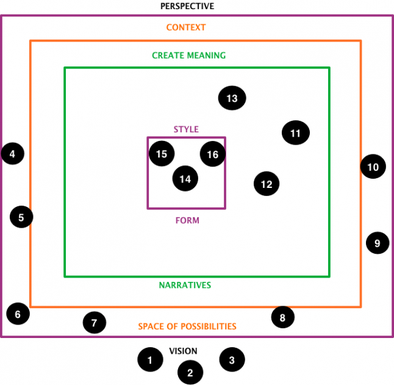
1. Not like World of Warcraft where people compete and feel lonely.
2. A feeling of accomplishment and empowerment that will make players care about each other.
3. A feeling of awe, of catharsis, in an online world.
4. Get rid of the power
5. Get rid of noisy stuff that distracts player's from each other.
6. Remove HUD so players get closer to each other
7. No ID (no nameplate)
8. No lobby
9. No guns
10. Get rid of players and make them two so they can focus on each other
11. Life cycle journey through; graveyard, waterfall, desert, canyon, cave, ruin, mountain, the summit
12. Resources are re-usable and dropped after being used by another player.
13. By being close players get extra power to complete a task together
14. Collaboration
15. Resources/power
16. Movements
Step 2
From step 1 Chen and his team choose to present through the plotting of a pattern following parts for the player to learn:
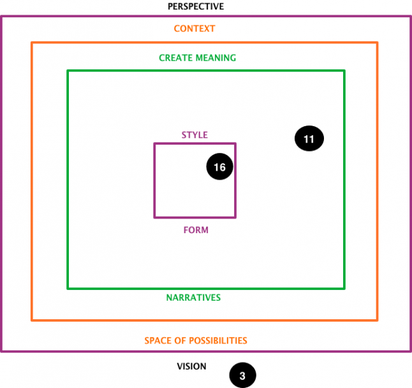
3. A feeling of awe, of catharsis, in an online world.
11. The desert
16. Movements
Even if the player doesn´t feel the meaning of “awe, of catharsis” when starting the game, the narrative assists the stylish elements to embody the goal (3) to create a pattern of an overall form for the gameplay.
As we know that the player likes to move to explore, we can see how the core mechanics of movements (16) assist the player´s core cognitive activities to move through the desert (11).
Step 3
Since I like to give a sense of a more detailed plotting of a pattern and how more stylish elements are added to the players learning about the plotting towards the goal, I will pick a few more parts from step 1 as to show how it looks:
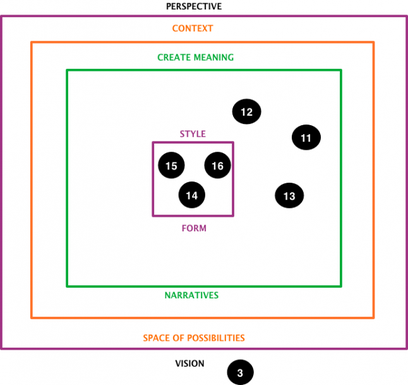
3. A feeling of awe, of catharsis, in an online world.
11. The desert
12. Resources are re-usable and dropped after being used by another player.
13. By being close players get extra power to complete a task together
16. Movements
15. Resources/power
14. Collaboration
By looking at the core mechanics (now presented in an new order due to the plotting 16, 15, 14) one can see how the player first learn about the movements (16), while being in the desert (11) and then the player learn about the recourses (15) and will then meet another player (12 and 13) where the mechanic of collaboration (14) is added to the plotting towards the goal (3) for the player to learn about the plotting (11 – 16).
When the player got this far in learning about the plotting, we can be pretty sure the form has spurred emotions.
But there is another interesting thing that has happened…
The player feels
When the player meets another player, what has happened through the learning shown in step 3 of the game is that the unfamiliar at the beginning of the game (step 2) has become the familiar. What will be experienced, as the unfamiliar, will be from the player´s feelings from its prior experiences and knowledge inside the context, as “being” the character inside the game world.

Journey, Thatgamecompany, Sony Computer Entertainment
Since this leads us back to where we started with the importance of understanding a “well-balanced” way of letting the expectations, that are built, correspond to the goal that indicates what the player will experience. If something doesn´t correspond to our expectations by something that gets too unfamiliar it will spur emotions that will make us feel “anxious”. By knowing how the narrative as a cognitive process works by assisting the stylish elements in creation of an overall form of a meaningful gameplay, it´s easier to understand why the change of form in “Journey”, before the game ended, caused a negative emotion and feeling from the loss of control (the lost from “being” the character in the game world and the loss of everything the player had learned). Since the cognitive activities were invested by learning inside the game world, but where the conflicting elements of something unfamiliar occurred outside the world (by the construction that changed the form), the responsibility is on the constructor to understand how form and style works on the perceiver´s core cognitive activities and how a negative response to an emotion can be very valuable as to detect the inconsistency in order to adjust it.
I often hear the question about “Journey”, which was made in 2012, what will happen if you play the game today and no players are playing the game any longer? By knowing how the familiar in relation to the unfamiliar involves and spurs our emotions, it gets a lot easier to understand why “Journey´s” single player mode works, as well as the today´s “search” for other players to appear involves. As what has become of the overall form today is that the familiar (the prior knowledge and experiences from being/learning inside the world) in relation to the unfamiliar, to see a player appear in the haze, the feeling of “awe, of catharsis” (without having to use a 500 watts lamp) might have never felt so strong as it does today from playing the online game "Journey".
If you found the series interesting, I recommend you to visit Narrative construction and read the post "2 plus 2 but not 4", which is about dialogues as a stylish element from the perspective of the narrative as a cognitive and dynamic element and how it can give meaning to an experience.
Katarina Gyllenbäck
Illustration by Linnea Österberg
PS If you would like to check out your new narrative glasses, try them on Walter White from the television series “Breaking Bad” to see how the familiar in relation to the unfamiliar involve.

You May Also Like